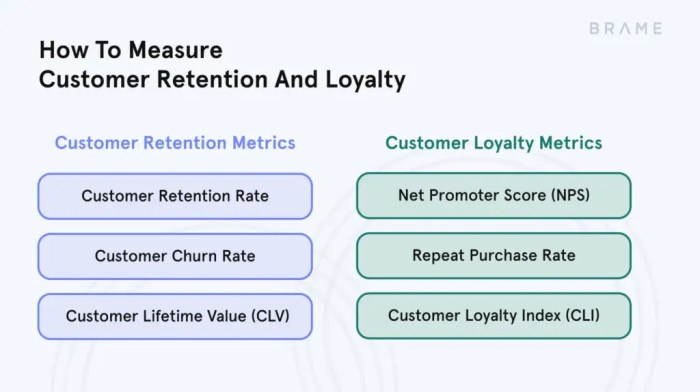Understanding Customer Retention Metrics is like deciphering the secret code to unlocking business prosperity. Dive into the realm of customer data analysis and watch as businesses harness the power of numbers to secure their future.
From unraveling the significance of customer behavior patterns to implementing personalized strategies, this journey will unveil the hidden gems of customer retention metrics in a way that’s both enlightening and captivating.
Importance of Customer Retention Metrics
Understanding customer retention metrics is crucial for businesses as it provides valuable insights into how satisfied customers are with the products or services offered. By tracking and analyzing these metrics, companies can identify areas of improvement, tailor their marketing strategies, and enhance customer experience to increase loyalty and retention rates.
Customer retention metrics directly impact a company’s bottom line by influencing revenue and profitability. For example, acquiring a new customer can cost five times more than retaining an existing one. Therefore, by focusing on retaining customers through effective strategies informed by metrics, businesses can reduce customer acquisition costs and boost overall revenue.
Moreover, customer retention metrics play a vital role in long-term business sustainability. By fostering strong relationships with existing customers and keeping them engaged, companies can create a loyal customer base that provides consistent revenue streams over time. This not only helps in withstanding market fluctuations but also strengthens the brand’s reputation and credibility in the competitive landscape.
Key Customer Retention Metrics
In the world of business, measuring customer retention is crucial for long-term success. By analyzing key customer retention metrics, businesses can gain valuable insights into customer behavior and make informed decisions to improve relationships and loyalty.
Churn Rate
Churn rate is a vital customer retention metric that measures the percentage of customers who stop using a product or service over a specific period. A high churn rate indicates that customers are leaving, which can negatively impact the business. Businesses use this metric to identify areas for improvement and implement strategies to reduce customer attrition.
Loyalty Rate
Loyalty rate is another important metric that measures the percentage of customers who continue to purchase from the same company over time. A high loyalty rate indicates strong customer relationships and repeat business. Businesses can use this metric to reward loyal customers, personalize marketing efforts, and increase customer retention.
Customer Lifetime Value
Customer lifetime value (CLV) is a metric that calculates the total revenue a business can expect from a customer throughout their entire relationship. By understanding CLV, businesses can prioritize customer segments, tailor marketing campaigns, and optimize customer experiences to maximize long-term profitability.
Real-World Examples
– Amazon utilizes churn rate to analyze customer retention and improve their subscription services like Amazon Prime.
– Starbucks tracks loyalty rate through their rewards program to incentivize repeat purchases and increase customer loyalty.
– Apple calculates customer lifetime value to target high-value customers with personalized offers and enhance overall customer satisfaction.
Analyzing Customer Behavior: Understanding Customer Retention Metrics

Customer behavior data plays a crucial role in understanding customer retention metrics. By analyzing how customers interact with a business, companies can gain valuable insights into their preferences, needs, and overall satisfaction levels. This data can then be used to tailor retention strategies effectively and improve customer loyalty.
Significance of Analyzing Customer Behavior Patterns
- Identifying Trends: Analyzing customer behavior patterns allows businesses to identify trends and patterns in customer interactions. This information can help predict future behavior and anticipate customer needs.
- Improving Customer Experience: By understanding how customers engage with a business, companies can identify pain points and areas for improvement in the customer experience. Addressing these issues can increase customer satisfaction and retention.
- Personalizing Marketing Efforts: Customer behavior data enables businesses to segment their customer base and personalize marketing efforts. By targeting customers with relevant offers and messages, companies can increase engagement and loyalty.
Leveraging Customer Behavior Insights for Retention Strategies
It is essential for businesses to leverage customer behavior insights to tailor retention strategies effectively and improve customer loyalty.
- Segmentation: By segmenting customers based on their behavior, businesses can create targeted retention strategies for different customer groups. This personalized approach can increase the effectiveness of retention efforts.
- Predictive Modeling: Analyzing customer behavior data can help businesses build predictive models to forecast customer churn and proactively address potential issues before they arise.
- Feedback Loop: Continuously analyzing customer behavior allows businesses to gather feedback on their products and services. By listening to customer feedback and making necessary adjustments, companies can enhance customer satisfaction and retention.
Strategies for Improving Customer Retention

In order to enhance customer retention rates, businesses can implement proactive strategies based on customer retention metric analysis. By analyzing key metrics, companies can identify areas for improvement and tailor their approach to better meet customer needs and expectations. Personalized customer experiences play a crucial role in fostering customer loyalty and increasing retention rates.
Implementing Loyalty Programs
- Offering rewards, discounts, and exclusive deals to loyal customers
- Creating personalized offers based on customer purchase history
- Providing early access to new products or services for loyal customers
Enhancing Customer Service
- Training employees to provide exceptional customer service
- Implementing chatbots or AI technology for quick and efficient customer support
- Collecting feedback and actively listening to customer concerns to improve service
Building Strong Relationships, Understanding Customer Retention Metrics
- Engaging with customers through social media and email marketing
- Personalizing communication to make customers feel valued and understood
- Organizing customer appreciation events or gatherings to strengthen relationships
Case Studies of Successful Customer Retention Strategies
Amazon Prime’s subscription model offering fast shipping, streaming services, and exclusive deals has significantly increased customer loyalty and retention rates.
Starbucks’ loyalty program, with rewards for frequent purchases and personalized offers, has led to a loyal customer base and increased retention rates.
The Role of Personalized Customer Experiences
- Creating tailored recommendations based on past purchases and browsing history
- Offering personalized promotions and discounts to individual customers
- Using customer data to anticipate needs and provide a seamless shopping experience






